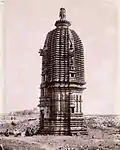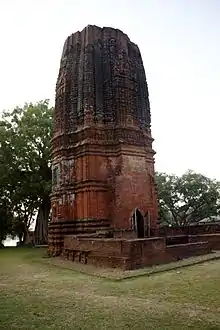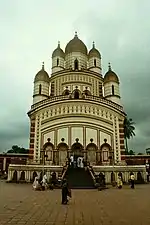Ichhai Ghosher Deul
Ichhai Ghosher Deul, also called tower temple (rekha-deul), is located near Gourangapur in the Indian state of West Bengal. It belongs to a small sub-group of Bengali temples, the architectural suggestions from Odisha can be traced back.[1][2]
| Ichhai Ghosher Deul | |
|---|---|
 | |
| Religion | |
| Affiliation | Hinduism |
| Location | |
| Location | Gourangapur Paschim Bardhaman |
| State | West Bengal |
| Country | India |
 Shown within West Bengal  Ichhai Ghosher Deul (India) | |
| Geographic coordinates | 23.6097°N 87.4523°E |
| Architecture | |
| Type | Rekha deul |
| Completed | 16th-17th century |
Location
The Ichai-Ghosh-temple is largely isolated by the river Ajay in the vicinity of the locality Gourangapur in the Paschim Bardhaman district in West Bengal, about 40 km (driving distance) North of Kolkata. Whether it has been in the vicinity of the temple, formerly a village, or whether the temple was a regional pilgrimage center, is unclear.[2]
History
On the Client, and thus also on the emergence time of the temple, nothing is known. Dating from the 7. up to 11. Century circulate as well as construction times from the 16. up to the age of 18. Century.[2]
According to Binoy Ghosh, Ichhai Ghosher Deul is located at Gourangapur. It is one of the few rekh-deuls in Bengal. Scholars date it around 16th-17th century and it was possibly erected by the descendants of Ichhai Ghosh, to perpetuate his memory.[2]
David J. McCutchion mentions Ichhai Ghoser Deul at Gourangapur as a large smooth curvilinear rekha deul, having a base of 20 feet square. It is a plain brick structure but for niches and images on tower.[3]
According to the List of Monuments of National Importance in West Bengal, the Ichhai Ghosh Temple is a monument of national importance.[4]
Consecration
There is neither a cult nor any other sculptural or inscription are references, you also have the consecration of the temple is unclear. The regional, according to Tradition, was Ichai Ghosh, a regional leader of an army, the in the 7. Century temporarily to the usurper swung open.
Architecture
The only one is about 18 m high tower (rekha-deul) with screen top (chhatri) and an internal, windowless Cella (garbhagriha) existing brick temple stands on a nearly square base of about 9,10 × 9,00 m; the basic dimensions of approximately 4.50 m high Cella, in contrast, amounts only to about 2.50 × 2.50 m. Noteworthy are the – however, for a Rekha-Deul usual – steep proportions in the lower part by a plurality of cornices are arranged, whereas in the upper part only vertical gradation find. A dome-shaped curvature of the construction developed only in the last meters.[5]
Building Decoration
The austere round-arched portal, is of a rectangular frame enclosed; each of the two niches in of amalaka and kalasha - crowned fields of the upper Zone show on all four sides of polyfoil arches and not further identifiable figures of gods. Bright plaster residue on the outer walls point to the fact that the temple was temporarily plastered.[2]
Photos of Rekha-Deul temples in West Bengal
 Stone Temple of Para, Purulia district
Stone Temple of Para, Purulia district Panchanana Temple at Barakar, Paschim Bardhaman district
Panchanana Temple at Barakar, Paschim Bardhaman district Jatar Deul-Temple, South 24 Parganas district
Jatar Deul-Temple, South 24 Parganas district Siddheshwara Temple, Bahulara, Bankura district
Siddheshwara Temple, Bahulara, Bankura district Temple, Banda, Purulia district
Temple, Banda, Purulia district Pratapeswar-Temple, Kalna, Purba Bardhaman district
Pratapeswar-Temple, Kalna, Purba Bardhaman district
References
- "Architecture". Banglapedia. Retrieved 6 September 2009.
- Ghosh, Binoy, Paschim Banger Sanskriti, (in Bengali), part I, 1976 edition, pages 123-129, Prakash Bhaban, Kolkata
- McCutchion, David J., Late Mediaeval Temples of Bengal, first published 1972, reprinted 2017, page 20, The Asiatic Society, Kolkata, ISBN 978-93-81574-65-2
- "List of Ancient Monuments and Archaeological Sites and Remains of West Bengal - Archaeological Survey of India". Item no. 51. ASI. Retrieved 25 January 2020.
- McCutchion, David J., Late Mediaeval Temples of Bengal, first published 1972, reprinted 2017, page 25, The Asiatic Society, Kolkata, ISBN 978-93-81574-65-2
External links
- Ichai-Ghosh-Temple – photos + Short Infos (English)
- Ichai-Ghosh-Temple – photo + Infos (English)
